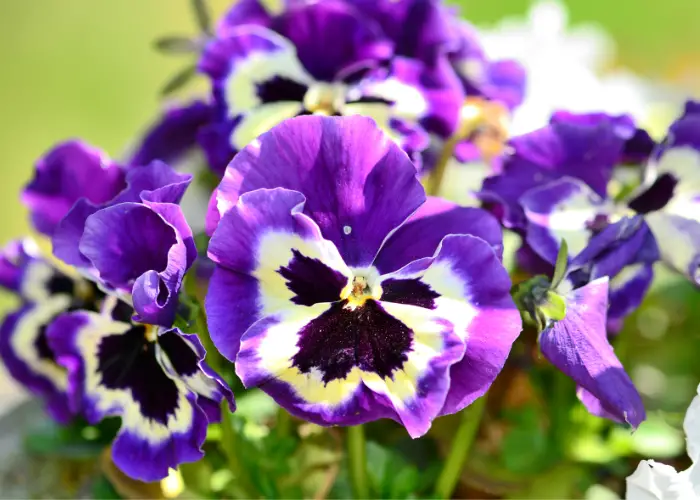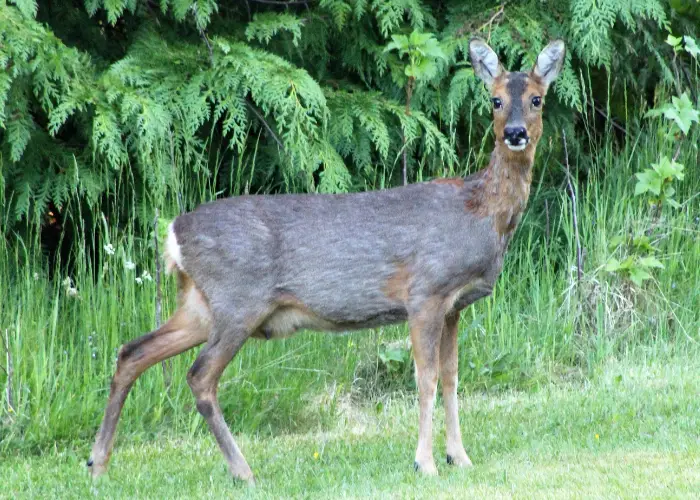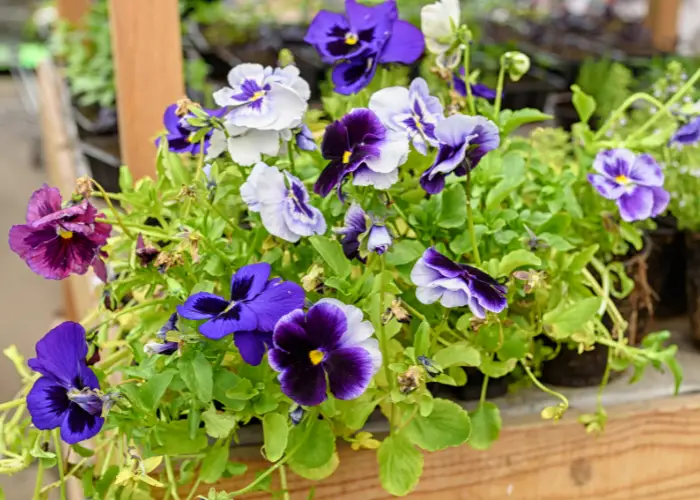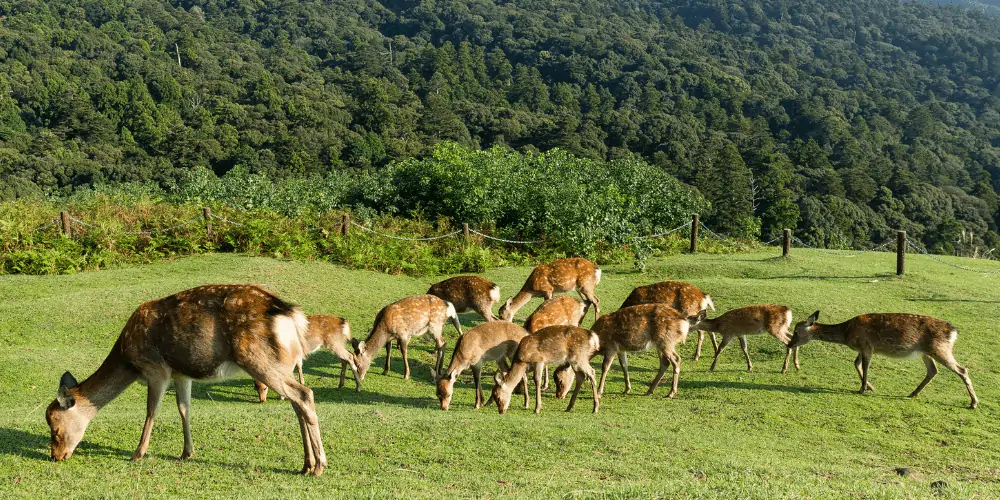If you’ve ever marveled at the beauty of pansies in your garden, you might have wondered, “Do deer eat pansies?”
Deer do eat pansies. Pansies are among the plants that deer find attractive due to their colorful appearance, taste, and scent. The high water content and soft texture of pansies make them a tasty snack for deer, especially in spring when tender new buds form.
We will uncover why deer find pansies irresistible and explore ways to protect your beloved blooms from these hungry visitors.
Stick around to learn how to safeguard your pansies and keep your garden flourishing!
Why Do Deer Eat Pansies?

Pansies, known for their vibrant colors and delicate petals, are more than just a feast for the eyes in a gardener’s paradise.
These flowers represent a much-needed source of nutrition for deer, especially in environments where their natural food sources are scarce. The attraction of deer to pansies can be attributed to several factors:
- Nutritional Value: Pansies are rich in proteins and vital nutrients essential for deer, especially in the colder months when food is scarce. This nutritional aspect makes pansies more than just a casual snack for these animals.
- Sensory Appeal: The bright colors of pansies are not just visually appealing to humans; they also attract deer. Their keen sense of smell is drawn to the sweet fragrance of pansies, making these flowers an irresistible treat.
- Taste: Pansies have a unique flavor profile that appeals to deer. Pansies are known for their mild and enticing flavor, unlike other plants with bitter or unpalatable tastes.
- Accessibility: Often planted in inaccessible garden beds and borders, pansies are easily reachable for deer, making them a convenient food source.
The Impact of Deer on Pansy Gardens

When deer find their way into a garden filled with pansies, the impact can be more significant than most gardeners anticipate. Understanding this impact is crucial for effective garden management:
- Extent of Damage: Deer, known for their voracious appetites, can consume large quantities of pansies in one visit. This consumption isn’t limited to the flowers alone; deer often eat the leaves and can even damage the stems and roots, affecting the plant’s overall health and growth.
- Frequency of Visits: If deer discover a reliable food source in a garden, they are likely to return, leading to repeated damage. This frequent foraging can hinder the pansies’ ability to recover and bloom.
- Long-Term Effects: Repeated deer visits can lead to long-term consequences for a pansy garden. The stress on the plants can reduce blooming, stunt growth, and in severe cases, lead to the death of the plants.
- Impact on Garden Ecosystem: The presence of deer in gardens can also affect the broader ecosystem. Their selective eating habits can alter the plant diversity and affect the garden’s health and appearance.
Preventative Measures to Protect Pansies

Protecting your pansies from deer is crucial for maintaining a healthy and vibrant garden. There are several effective strategies that gardeners can employ:
- Natural Deterrents:
- Companion Planting: Planting deer-resistant plants alongside pansies can significantly reduce their appeal. Plants like marigolds, lavender, or garlic can act as natural repellents.
- Odor and Taste Repellents: Homemade or commercial sprays that create an unpleasant taste or smell for deer can be applied to pansies, deterring deer without harming the plants.
- Physical Barriers:
- Fencing: Installing a fence that is at least 8 feet tall can effectively prevent deer from accessing the pansies.
- Netting: For smaller gardens, protective netting can be a practical solution.
- Chemical Deterrents:
- Safe and effective chemical repellents can be sprayed on and around pansies. It’s important to choose environmentally friendly products and safe for other wildlife.
- Innovative Solutions:
- Case Studies: Highlighting real-life examples and testimonials from gardeners who have successfully implemented these strategies.
- DIY Solutions: Providing readers with creative and cost-effective DIY deer deterrent ideas.
Alternative Plants to Distract Deer

While protecting pansies is crucial, offering alternative plants that deer prefer can be an effective strategy to keep them away from your prized flowers. Here are some suggestions:
- Deer-Friendly Plants:
- Asters and Daisies: These plants are often more appealing to deer than pansies and can serve as a distraction.
- Herbs like Rosemary and Thyme: While not typically the first choice for deer, these can be more attractive alternatives when other food sources are scarce.
- Strategic Planting:
- Planting these alternatives at a distance from pansies can draw deer away, minimizing the risk of them stumbling upon your pansies.
- Creating a ‘buffer zone’ with these plants can be an effective way to safeguard your pansies.
- Understanding Deer Preferences:
- Deer tend to prefer plants that are high in moisture and nutrients. Selecting alternatives that meet these criteria can more effectively divert their attention.
- Seasonal Considerations:
- Adjusting your planting strategy based on the season can also be beneficial, as deer’s food preferences change throughout the year.
Practical Tips for Gardeners

Assessing Deer Damage
- Identifying Signs: Look for distinct signs of deer presence, such as hoof prints, droppings, or the unique pattern of damage they leave on plants. Deer tend to leave a jagged or torn edge on leaves and stems because they have no upper front teeth and must jerk or pull the plant when eating.
- Evaluating Plant Health: Assess the health of your pansies after a deer visit. If the damage is severe, with most of the foliage gone, the plant’s ability to photosynthesize is compromised, affecting its growth and flowering.
Repairing Deer Damage
- Immediate Actions: If deer have nibbled on your pansies, gently prune the damaged areas. This helps to stimulate new growth and can encourage the plant to produce more flowers.
- Long-Term Recovery: Support the long-term recovery of your plants by ensuring they have adequate water and nutrients. A balanced fertilizer can promote healthy growth and help your pansies bounce back.
Monitoring and Maintenance
- Routine Inspections: Establish a routine to inspect your garden, especially during early morning or late evening when deer are most active. This can help you spot and address any new damage quickly.
- Adaptive Gardening Practices: Consider adapting your gardening practices to deter deer. This might include changing the layout of your garden, using motion-activated sprinklers, or installing physical barriers like fencing or netting.
Creating a Deer-Resistant Garden
- Strategic Planting: Design your garden with deer resistance in mind. Use plants known to be less appealing to deer around the perimeter of your garden. Plants with strong scents, like lavender or garlic, can act as natural repellents.
- Diverse Plant Selection: Incorporate a variety of plants that are unattractive to deer. This not only protects your garden but also promotes biodiversity.
Conclusion

While deer are naturally drawn to the beauty of pansies, your garden can flourish with the right strategies.
Understanding deer behavior and implementing physical barriers, natural deterrents, and smart planting can protect your pansies.
Gardening is a journey of adaptation, and facing the challenge of deer is part of this rewarding experience.
Embrace these strategies to enjoy the tranquility and beauty of your pansy garden, making it a testament to your resilience and care as a gardener.
Have you had experiences with deer in your garden?
Share your stories and tips in the comments below!
REFERENCES:
- Mississippi State University Deer Lab. (2019). What Do Deer Eat? | Deer Ecology & Management Lab | Mississippi State University. Retrieved from https://www.msudeer.msstate.edu/deer-diet.php
- USDA Forest Service. (1984). What do deer eat and why [Scientific Journal]. In L. D. White & D. Guynn (Eds.), Holistic ranch management–putting it all together: Proceedings of the 1984 international ranchers roundup; 1984 July 30-August 3; San Angelo, TX. Uvalde, TX: Texas Agricultural Research and Extension Center, Texas A&M University: 266-276.




